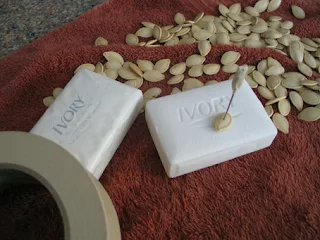Brief Description: Stringing seeds to create jewelry and garlands is done by many different cultures of peoples. The seed necklace pictured here is from Mexico. However, native peoples in North America and many tribal peoples from Africa create similar crafts that also use the same methods. Seed necklaces are actually best strung while the seeds have not yet fully dried. This method makes it much easier for children to prick holes into the seed shells.
Supply List:
- A variety of seeds
- strong thin cord or dental floss for stringing
The seed necklace above is from Mexico. - An embroidery needle with a sharp tip
- one bar of ivory soap
- a soft terry cloth towel
- masking tape
- one small pumpkin
- one large metal spoon
- access to a wash basin or a large bucket of water
- knife to cut open the pumpkin
- liquid dish soap
Directions:
- Cut your pumpkin in half and hollow out it's interior with a large metal spoon.
- The seeds are easy to clean. Just soak them for a few minutes in the bucket of water and the pumpkin pulp with separate from the seeds with a little plucking on your part.
- Wash the seeds with a little liquid soap and then pat them down with a soft terry cloth towel.
- Wrap the dull end of your embroidery needle with a little masking tape, so that it will be easier to handle.
- Pierce each soft, pumpkin seed with a threaded needle.
- Use a bar of Ivory soap underneath your needle to keep it sharp and to avoid contact with surfaces or flesh.
 |
| A fresh pumpkin will provide ample seeds for a necklace or garland. |










